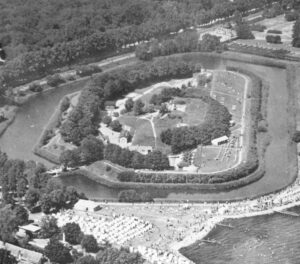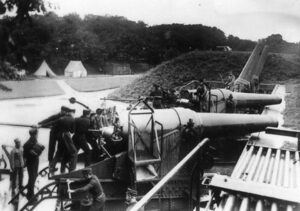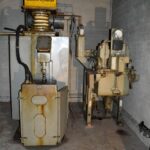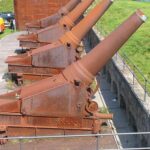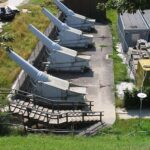The Charlottenlund Battery, later referred to as the Charlottenlund Fort, was built during the years 1886 to 1888.
It was a coastal battery and was part of the series of coastal batteries intended to protect Copenhagen from the sea side.
It was part of the middle defence line together with the Middelgrund Fort and the Kastrup Battery.
It was built as an open works enclosed with earth.
It has a rectangular shape and is surrounded by a 25-40 meter wide and 2.5-3 meter wet moat.
The fort itself is 300 meters long and 130 meters wide. The front is 33 meters thick and 6 meters thick on the flanks and throat.
The ammunition magazine was located on the right side of the area and was covered by 30 meters of eath . From the magazine, the ammunition could be fed to the concrete emplacements through two tunnels.
To the north of the large traverse was a yet another traverse as well as smaller traverse between every two guns.
There were no safe living areas for the crew, only some wooden barracks on the grounds. However, an explosive-proof casemate was found in the south-west corner of the large traverse.
Originally, the battery was fitted with 2 pcs. of 35.5 cm. guns on each side of the large traverse, 2 pcs. of 15 cm. guns north of the northernmost of the heavy guns and on each wing a 47 mm. quick fast-firing gun. There were also 2 pcs. of 75 mm. guns.
The battery had two 90 cm floodlights as well as 2 pcs. of distance measuring stations.
During the years 1910 to 1912 the battery was modernized.
In connection with the 5 existing ammunition magazines in the large traverse, a casemate building was built with an engine rooms and 7 rooms for the crew.
Towards the sea side, the armament was changed, and there was mounted 2 pcs. of 120 mm. guns on concrete emplacements south of the large traverse and 4 pcs. 29 cm. haubits in a battery.
North of the large traverse 4 pcs. of 29 cm. haubits were mounted om a concrete enplacement in a battery, a large traverse with built-in ready-to-use ammunition storages and north of this additional 4 pcs. of 29 cm. haubits. and 2 pcs. of 120 mm. guns.
On the area towards the land side, 2 pcs. 37 mm. revolver guns were mounted.
On the fort were two more 75 mm. cannons, stored in cannon sheds on the terreplein.
For the close defense, the fort had 10 machineguns.
The defence of the moat consisted of 3 flanking positions.
During World War I, additional emplacements were added to 2 pcs. of 17 cm. guns on the large traverse. However, these were never placed.
Furthermore, a concrete emplacement was mounted with a 47 mm. balloon cannon on the large traverse.
The fort was provided with 2 pcs. of 150 cm. floodlights, 1 in an elevator in a well immediately north of the large traverse and 1 on a rail track at the foot of the front.
- The Gate
- The moat
- Side entrance
- The floodlight
- Transformer
- 29 cm. haubits
- 29 cm. haubits
- Caponiere in the mout
- Turret for distance messurer
- Traverse
- Emplacement for artillery
- Emplacement for artillery
- Enplacements for artillery

